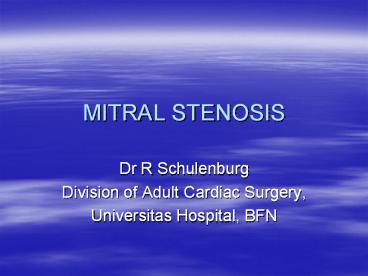MITRAL STENOSIS - PowerPoint PPT Presentation
Title:
MITRAL STENOSIS
Description:
MITRAL STENOSIS Dr R Schulenburg Division of Adult Cardiac Surgery, Universitas Hospital, BFN Etiology and Essential Pathology Predominately post-inflammatory ... – PowerPoint PPT presentation
Number of Views:2140
Avg rating:3.0/5.0
Title: MITRAL STENOSIS
1
MITRAL STENOSIS
- Dr R Schulenburg
- Division of Adult Cardiac Surgery,
- Universitas Hospital, BFN
2
Etiology and Essential Pathology
- Predominately post-inflammatory scarring(other
malignant carcinoid, SLE) - Fibroreactive transformation of the valve
- Affecting all segments of the valvular apparatus
- Calcifications at commisural edges lead to
classic fish-mouth appearance - Only 25 have pure MS
3
Pathophysiology
- Reduction in MVA with a rise in atrioventricular
gradient - LA hypertrophy and imposes a pressure load on the
RV through the development of pulmonary
hypertension - Increases in RV end-diastolic pressure and volume
cause RV dilatation which may result in
funtional TVR(annular dilatation)
4
Pathophysiology
- LV diastolic function is usually preserved
although there may be(25) dysfunction in
patients with severe, chronic MS(chronic preload
reduction and/or extension of scarring from the
valve to adjacent myocardium) - Systemic effects of severe TVR
5
Classification and Natural History
- Mild(MVAgt1.5, MGlt5mmHg, PASPlt30mmHg)
- Moderate(MVA 1-1.5, MG 5-10mmHg, PASP 30-50mmHg)
- Severe(MVAlt1, MGgt10mmHg, PASPgt50mmHg)
6
Natural History
- MVgt1.5 usually does not produce symptoms at rest
- Symptoms develop when the LAP increases(Dyspnoea)
gt5mmHg - Occurs when there is an increase in transmitral
flow or a decrease in diastolic filling
time(exercise, emotional stress, infection,
pregnancy, AF with a rapid ventricular response)
7
Nutural History
- MS is a continuous, progressive, life-long
disease, usually consisting of a slow, stable
course in the early years followed by a
progressive acceleration in later life - Once symptoms develop, there is another period of
almost a decade before symptoms become disableing - Asymptomatic/minimally symptomatic survival is
80 at 10yrs but once significant limiting
symptoms develop, there is a dismal 0-15 1-year
survival rate
8
Natural History
- When severe pulmonary HPT develops , mean
survival drops to lt3yrs - 60-70-progressive pulmonary and systemic
congestion - 20-30-systemic embolism
- 10-pulmonary embolism
- 1-5-infection
9
Diagnosis
- History slow, indolent increase in dyspnoea and
general fatigue(any sudden change in symptom
complex should raise suspicion!) - ClinicalRV heave, Apex beat, Diastolic rumble,
Opening snap - ECG
- CXRCardiac chamber enlargement, Pulmonary venous
hypertension, Pulmonary arterial hypertension - ECCHO/TEE
- Cardiac cath
10
Management
- Medical AB prophylaxis, diuretics, negetive
chronotropic drugs, atrial fibrillation - Interventional Percutaneous balloon valvotomy
- Surgical Cosed/open commissurotomy, MVR































